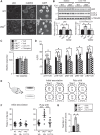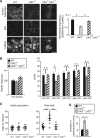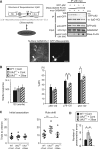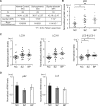Ulk2 controls cortical excitatory-inhibitory balance via autophagic regulation of p62 and GABAA receptor trafficking in pyramidal neurons
- PMID: 29893844
- PMCID: PMC6121199
- DOI: 10.1093/hmg/ddy219
Ulk2 controls cortical excitatory-inhibitory balance via autophagic regulation of p62 and GABAA receptor trafficking in pyramidal neurons
Abstract
Autophagy plays an essential role in intracellular degradation and maintenance of cellular homeostasis in all cells, including neurons. Although a recent study reported a copy number variation of Ulk2, a gene essential for initiating autophagy, associated with a case of schizophrenia (SZ), it remains to be studied whether Ulk2 dysfunction could underlie the pathophysiology of the disease. Here we show that Ulk2 heterozygous (Ulk2+/-) mice have upregulated expression of sequestosome-1/p62, an autophagy-associated stress response protein, predominantly in pyramidal neurons of the prefrontal cortex (PFC), and exhibit behavioral deficits associated with the PFC functions, including attenuated sensorimotor gating and impaired cognition. Ulk2+/- neurons showed imbalanced excitatory-inhibitory neurotransmission, due in part to selective down-modulation of gamma-aminobutyric acid (GABA)A receptor surface expression in pyramidal neurons. Genetically reducing p62 gene dosage or suppressing p62 protein levels with an autophagy-inducing agent restored the GABAA receptor surface expression and rescued the behavioral deficits in Ulk2+/- mice. Moreover, expressing a short peptide that specifically interferes with the interaction of p62 and GABAA receptor-associated protein, a protein that regulates endocytic trafficking of GABAA receptors, also restored the GABAA receptor surface expression and rescued the behavioral deficits in Ulk2+/- mice. Thus, the current study reveals a novel mechanism linking deregulated autophagy to functional disturbances of the nervous system relevant to SZ, through regulation of GABAA receptor surface presentation in pyramidal neurons.
Figures





Similar articles
-
BDNF controls GABAAR trafficking and related cognitive processes via autophagic regulation of p62.Neuropsychopharmacology. 2022 Jan;47(2):553-563. doi: 10.1038/s41386-021-01116-0. Epub 2021 Aug 2. Neuropsychopharmacology. 2022. PMID: 34341497 Free PMC article.
-
DISC1 Protein Regulates γ-Aminobutyric Acid, Type A (GABAA) Receptor Trafficking and Inhibitory Synaptic Transmission in Cortical Neurons.J Biol Chem. 2015 Nov 13;290(46):27680-7. doi: 10.1074/jbc.M115.656173. Epub 2015 Sep 30. J Biol Chem. 2015. PMID: 26424793 Free PMC article.
-
ULK2 is essential for degradation of ubiquitinated protein aggregates and homeostasis in skeletal muscle.FASEB J. 2019 Nov;33(11):11735-11745. doi: 10.1096/fj.201900766R. Epub 2019 Aug 9. FASEB J. 2019. PMID: 31361156 Free PMC article.
-
A GABAergic cortical deficit dominates schizophrenia pathophysiology.Crit Rev Neurobiol. 2004;16(1-2):1-23. doi: 10.1615/critrevneurobiol.v16.i12.10. Crit Rev Neurobiol. 2004. PMID: 15581395 Review.
-
Impaired prefrontal inhibition in schizophrenia: relevance for cognitive dysfunction.Physiol Behav. 2002 Dec;77(4-5):501-5. doi: 10.1016/s0031-9384(02)00936-8. Physiol Behav. 2002. PMID: 12526990 Review.
Cited by
-
Perturbed cell fate decision by schizophrenia-associated AS3MTd2d3 isoform during corticogenesis.Sci Adv. 2025 Mar 28;11(13):eadp8271. doi: 10.1126/sciadv.adp8271. Epub 2025 Mar 28. Sci Adv. 2025. PMID: 40153497 Free PMC article.
-
Molecular Basis of Neuronal Autophagy in Ageing: Insights from Caenorhabditis elegans.Cells. 2021 Mar 21;10(3):694. doi: 10.3390/cells10030694. Cells. 2021. PMID: 33800981 Free PMC article. Review.
-
Olfactory neuronal cells as a promising tool to realize the "druggable genome" approach for drug discovery in neuropsychiatric disorders.Front Neurosci. 2023 Mar 10;16:1081124. doi: 10.3389/fnins.2022.1081124. eCollection 2022. Front Neurosci. 2023. PMID: 36967982 Free PMC article.
-
Zinc Oxide Nanoparticles Exacerbate Epileptic Seizures by Modulating the TLR4-Autophagy Axis.Int J Nanomedicine. 2024 Feb 29;19:2025-2038. doi: 10.2147/IJN.S442623. eCollection 2024. Int J Nanomedicine. 2024. PMID: 38476283 Free PMC article.
-
Autophagy-Based Hypothesis on the Role of Brain Catecholamine Response During Stress.Front Psychiatry. 2020 Sep 17;11:569248. doi: 10.3389/fpsyt.2020.569248. eCollection 2020. Front Psychiatry. 2020. PMID: 33093837 Free PMC article. Review.
References
-
- Mizushima N., Komatsu M. (2011) Autophagy: renovation of cells and tissues. Cell, 147, 728–741. - PubMed
-
- Hara T., Nakamura K., Matsui M., Yamamoto A., Nakahara Y., Suzuki-Migishima R., Yokoyama M., Mishima K., Saito I., Okano H., Mizushima N. (2006) Suppression of basal autophagy in neural cells causes neurodegenerative disease in mice. Nature, 441, 885–889. - PubMed
-
- Komatsu M., Waguri S., Chiba T., Murata S., Iwata J., Tanida I., Ueno T., Koike M., Uchiyama Y., Kominami E., Tanaka K. (2006) Loss of autophagy in the central nervous system causes neurodegeneration in mice. Nature, 441, 880–884. - PubMed
-
- Komatsu M., Wang Q.J., Holstein G.R., Friedrich V.L. Jr, Iwata J., Kominami E., Chait B.T., Tanaka K., Yue Z. (2007) Essential role for autophagy protein Atg7 in the maintenance of axonal homeostasis and the prevention of axonal degeneration. Proc. Natl. Acad. Sci. U.S.A., 104, 14489–14494. - PMC - PubMed
Publication types
MeSH terms
Substances
Grants and funding
LinkOut - more resources
Full Text Sources
Other Literature Sources
Medical
Molecular Biology Databases
Miscellaneous

